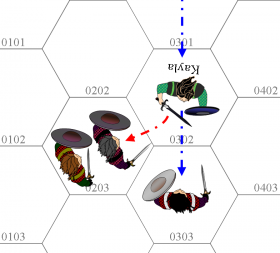Charging
Charging is a combat attack made at a run, in which the combatant uses that momentum to increase the chance of hitting and the amount of damage done, while also breaking the enemy's morale. The act of charging incorporates the effects of overbearing and attacks of opportunity, while momentarily suspending rules related to melee and adjusting the effects of stun lock.
Movement & Initiative
In order to charge, a combatant must be running or sprinting, which means that for each action point (AP) spent they are moving 4 or more hexes per round. The charger must indicate if their action will be a direct charge or a passing charge. The distance between the charger and the target is noted and the speed indicated, whereupon it is determined whether or not an attack of opportunity can or will take place. Once this attack is resolved, it must be determined whether or not the defender or defenders will break, which requires a morale check. Once morale is resolved, an initiative die must be rolled to determine who strikes first.
Because the defender has already received an attack of opportunity, the charger is awarded a +2 bonus to the initiative roll. Conversely, if the defender wins the initiative, the defender is +2 to hit the charger. These bonuses only apply at the moment of contact. If the charger wins initiative, the defender does not receive a +2 to hit after the charger's attack. That bonus is lost when the defender loses the initiative. Once the charge has been met, normal combat movement and attacks apply.
If combatants are charging one another simultaneously, then no attack of opportunity can be made, nor will either side make a morale check to see if they break. Neither side will receive a bonus to their initiative roll. Both sides will receive a +2 bonus to hit the other, regardless of who wins the initiative.
Direct Charges
A direct charge is a frontal attack against the enemy, intended to force the enemy back from the hex occupied. When a sufficient force of chargers rush a defending position, there is a chance that the defenders will break before the actual combat is met, a matter that must be determined before the charge makes contact.
When resolving this form of charge, the charger effectively receives two independent attacks: the first is a normal roll to hit and the second is an adjusted overbearing attack. Both of these attacks are combined, so that together they count as one attack. Characters able to perform multiple attacks a round would pay a single AP cost of 1 point for both attacks; any other character would pay a cost of 2 points.
If the charger has won initiative, or if the charger was missed when attacked by the defender, or if the amount of damage done failed to stun the charger, then the charger makes their first attack normally, with a weapon (or a fist), at +2 to hit the defender. When charging, if the enemy is stunned, the enemy falls back 60° left or right, and not straight back, which enables the charger to continue straight ahead if able.
Once this attack is resolved, the second attack determines whether or not the charger successfully overbears the enemy. Here, when calculating the charger's weight, a bonus of +50% is added. For example, if the charger's weight were normally 210 lbs., with respect to charging & overbearing, the charger is counted at 315 lbs. Overbearing is then resolved normally, with overbearing damage, except that as above, the successfully overborne character is pushed left or right and not straight back.
If the charger has sufficient movement, they may complete their movement into the overborne hex and attempt to overbear the next opponent in line. If the charger has another attack, they may again combine attack and overbearing in one movement, or they may only be able to overbear. This second attempt will be 50% of their modified first weight; so in the example above, the charger will be counted as 157 lbs. This process can continue so long as there are enemies in line with the combatant's charge; and the combatant still has movement; and overbearing succeeds, with each progressive attempt to overbear equally 50% of the previous charger's modified weight.
When charging with a mount, the mount's weight is also taken into account; and since the mount will have more potential movement than the rider, this progressive overbearing against foot soldiers can be a very effective attack. However, when riding a mount, the rider cannot combine a direct charging attack with overbearing; when riding, the mount overbears, while the rider performs a passing charge.
Passing Charges
A passing charge is a swinging attack against the enemy as the charger runs past, using speed to bypass the movement penalty when engaging in melee. This suspension of the melee-engage rule is possible because within the narrow window of the charge, the actual melee has yet to be initiated.
